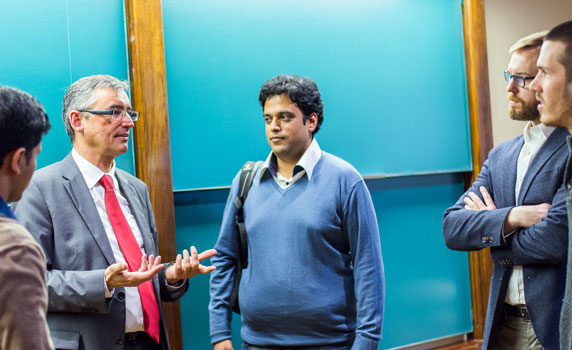
“Innovation leadership at all times. This is our goal. And it means turning challenges into opportunities, and creating successful business models along the way.”
Hubert Schurkus is Head of Corporate Human Resources, Strategy and Targets at automobile behemoth, BMW. Innovation, he says, keeps the company at the forefront in a competitive market that changes at breakneck speed. And as BMW prepares to celebrate 100 years in the car industry, the evidence would suggest the company remains on the right track.
Schurkus joined students of the IESE MBA program on campus in Barcelona this week to talk about the “uncompromising commitment to high quality and boundless curiosity” that underpins innovation at BMW. He highlighted five key factors or drivers for growth.
Keeping Pace With Shorter Strategy Cycles
Strategy cycles are getting shorter and shorter, says Schurkus. So staying ahead of the field means being very clear about goals, and taking an integrative, flexible and comprehensive approach to strategizing.
“For BMW, the goal is to be a leading provider of premium products and premium services for individual mobility,” he says. “We are very clear about what we want to achieve. What’s exceptional about the way we strategize is that it’s not an isolated process. It’s not about getting 10 people together and making a proposal.”
BMW takes a 360 degree approach, he say, that: “personally involves our board members and numerous executives, who provide significant iterative input. We analyze trends, deploy our resources to the full and dig deep in terms of customer analysis.”
Keeping up With Customers … And Trends
Innovation is built on timing, says Schurkus. That means having a clear understanding of customer behavior and recognizing trends. He points to the case of Blackberry and Kodak whose “poor timing” led to missed opportunities to exploit trends and grow. Nokia, he said, had missed out on the mobile to smartphone trend.
Keeping apace with trends is vital, says Schurkus. New EU regulations for carbon emissions for instance, will change the manufacturing landscape, he said. By 2025, emissions are expected to be 60-70 grams per kilometer. Manufacturers will need to factor this into their strategy and produce more sustainable cars.
Another trend he highlighting is the decrease in car ownership – and in drivers.
“Although individual mobility remains a priority, the number of drivers in countries like Japan, the U.S. and Germany is shrinking. You have to have maximum customer orientation and maximum flexibility because customer behavior continuously changes.”
Embracing Connectedness and Sharing
In response to trends in mobility and connectivity, BMW has recently introduced DriveNow, a car-sharing program that connects 300 customers in international cities to BMW cars – an innovation that was viewed with skepticism by others in the industry.
“With innovation you can’t be sure everything will work, but if you have to capitalize on the trends you see in good time. The music industry has changed from buying to using, leaving stragglers behind. The world changes with or without us, so you have to be proactive.”
Making a Real Commitment to Innovation
The “megatrend” in 2007 was sustainability, said Schurkus. BMW’s electric i3 car was released in response to the demand for cleaner automobiles. But the decision was not “knee-jerk,” he explains.
“The i3 was conceived as a series car, not just a box-ticker to be shown at the Geneva Auto Show. It required us to think outside the box. It was an opportunity to produce a 100 percent emission-free vehicle, manufactured with sustainable material and 95 percent recyclable. It was a real opportunity for BMW to become a pioneer in electro-mobility.”
When NGOs scrutinized the i3, says Schurkus, they understood that car represented a genuine part of BMW’s strategy and commitment.
“We don’t produce sustainable cars to be politically correct, or color your company green. We really want to define the future, and that’s the difference.”
The People That Make the Difference
Key to BMW’s success in innovation is its people, says Schurkus. “Without the talent, you cannot innovate.”
The BMW culture of trend recognition and flexibility, he says, is tied to the skills of its workforce. Regardless of what does or does not happen in technology, it is people who develop strategies, build the cars and inspire customers to buy them.
“You have to find the right people, the right mindset, and the right passion to lead in the future.”